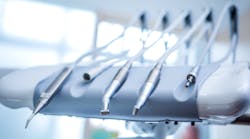In the movie Erin Brockovich, there’s a scene where the legal teams are sitting around a table, and Erin (played by Julia Roberts) says to the opposing council, “We brought that water in special for you, folks; it came from a well in Hinckley,” and the lawyer who was about to drink it sets it down and abruptly ends the meeting.
I can’t help but draw a parallel from this scene to the water in our dental operatories. If someone poured you a drink straight from your air/water syringe (aside from it taking forever to “pour”), would you hesitate to drink it? It might look clear, smell fine, and even taste normal. But how do you know if that water is indeed safe?
Dental unit waterlines (DUWLs) are the perfect environment for bacteria and biofilms to flourish. You know how it would take forever to fill that cup from your air/water syringe? But if you were to use your sink, it would fill up fast. That slow fill, otherwise known as flow rate, gives biofilm the perfect opportunity to form in the teeny-tiny porous lines in your chair. As that biofilm grows, it can then detach and end up in your patient’s mouth. And sadly, there are many cases where contaminated water has severely harmed patients.1
Here are three steps you can take to ensure your water is safe for you and your patients.
Shock
If all this waterline talk is new or if it’s been a while, it’s time to shock. Shocking is using a strong antimicrobial to blast out the biofilm. There are lots of products on the market. You have to leave some of them in overnight, and others work in as quickly as 10 minutes. Read the instructions for use (IFUs) and use the shock properly. If you choose an overnight product, be sure to put a sign in the operatory that says “Shock in progress.” Murphy’s Law says that if you're not there the next day, the temp will end up squirting shock into the first patient’s mouth!
Treat
Once you have shocked, it’s time to choose a treatment product. People often wonder why you need both a shock and a treatment product. I like to say shocking is like your perio maintenance visit where you really disrupt all the biofilm, and treating is the home care the patient does between visits to keep the biofilm from getting too out of control.
Like shock products, there are many treatment products on the market. Tablets and straws are the most common. These products deliver a patient-safe, low-level antimicrobial into the water, keeping the biofilm from growing too fast. Once again, read the IFUs and adhere to them.
Test
The CDC set the standard for safe dental water at 500 cfu/ml.2 The only way to know if your water meets those standards is to test it. There are two styles of tests on the market: mail-in and chairside. Both have advantages. Mail-in tests will give you a more specific count of the biofilm growing in your lines along with third-party verification that your lines are within safe standards. In comparison, chairside tests are cheaper and confidential.
At minimum, testing should occur monthly until you pass for two consecutive months, and then you can test quarterly.3 But check the IFUs for both your chair and treatment products in case they require testing more often.
What if you keep failing the test?
No one likes to fail, especially us perfection-minded hygienists. But if you do, know you are in good company. Nearly one-third of treated lines still fail.4 Biofilm is a beast. We know this from our patients’ mouths; waterlines are no different.
The good news is there are free resources that can help you build a successful protocol. Call the water safety experts at ProEdge Dental Water Labs at (888) 843-3343 or email [email protected]. No matter what product you’re using, they are there to help you troubleshoot and pass the test.
Then you can pour yourself a big cup of operatory water and know it’s safe.
Editor's note: This article appeared in the March 2024 print edition of RDH magazine. Dental hygienists in North America are eligible for a complimentary print subscription. Sign up here.
References
- Waterline contamination leads to 221 lawsuits in landmark Anaheim pediatric dentistry case. ProEdge Dental Water Labs. August 22, 2022. https://proedgedental.com/2022/08/waterline-contamination-anaheim/
- Guidelines for infection control in dental health-care settings – 2003. Morbidity and Mortality Weekly Report. Department of Health and Human Services. Centers for Disease Control and Prevention. December 19, 2003. https://www.cdc.gov/mmwr/PDF/rr/rr5217.pdf
- Mills SE, Porteous N, Zawada J. Dental unit water quality: Organization for Safety, Asepsis and Prevention white paper and recommendations–2018. Journal of Dental Infection Control and Safety. 2018;1(1):12-12.
- Molinari JA, Dewhirst N. Treating and Monitoring Dental Water Quality. Compendium of Continuing Education in Dentistry. September 2018. https://cdeworld.com/courses/5154-treating-and-monitoring-dental-unit-water-lines
Amanda Hill, BSDH, RDH, CDIPC, is an enthusiastic speaker, innovative consultant, and award-winning author who brings over 25 years of clinical dental hygiene and education to dentistry. Recipient of OSAP’s Emerging Infection Control Leader award and an active participant with the advisory board for RDH magazine, DentistryIQ, and OSAP’s Infection Control in Practice Editorial Review Board and membership committee, Amanda (also known as the Waterline Warrior) strives to make topics in dentistry accurate, accessible, and fun. She can be reached at [email protected].
About the Author

Amanda Hill, BSDH, RDH, CDIPC
Amanda Hill, BSDH, RDH, CDIPC, is an enthusiastic speaker, innovative consultant, and award-winning author who brings more than 25 years of clinical dental hygiene and education to dentistry. Recipient of ADS’s Emerging Infection Control Leader award and an active participant with the advisory board for RDH magazine, DentistryIQ, and ADS’s Infection Control in Practice Editorial Review Board and membership committee, Amanda (also known as the Waterline Warrior) strives to make topics in dentistry accurate, accessible, and fun. She can be reached at [email protected].


